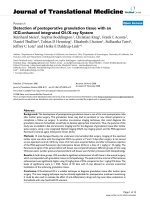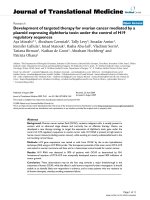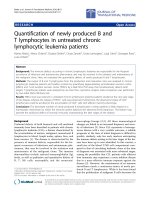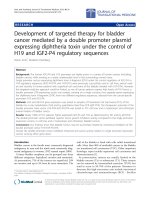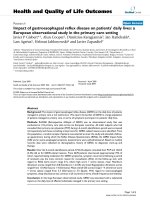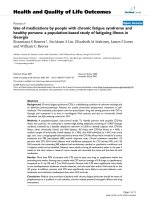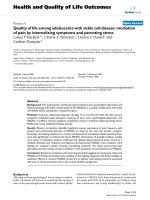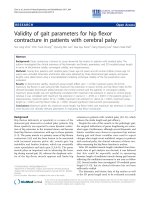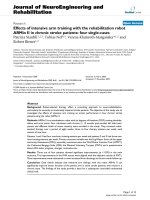báo cáo hóa học:" Base of coracoid process fracture with acromioclavicular dislocation in a child" ppt
Bạn đang xem bản rút gọn của tài liệu. Xem và tải ngay bản đầy đủ của tài liệu tại đây (885.26 KB, 4 trang )
CAS E REP O R T Open Access
Base of coracoid process fracture with
acromioclavicular dislocation in a child
Prithee Jettoo
*
, Gavin de Kiewiet, Simon England
Abstract
Fracture of the coracoid process is a rare injury. It can be easily missed whe n associated with other injuries to the
shoulder girdle, for instance, acromioclavicular joint (ACJ) dislocation. Clinical attention is easily drawn to the more
obvious ACJ dislocation, hence, the need for further radiological evaluation. We report an unusual case of fracture
of the base of coracoid process associated with a true acromioclavicular joint dislocation in a 12 year old boy, with
no separation of the epiphyseal plate, as one might expect. Treatment also remains controversial. Our patient
underwent open reduction internal fixation of the acromioclavicular joint and coracoid process. He subsequently
made an uneventful progress with pain free full range of shoulder movement at 5 months, and was discharged at
9 months.
Introduction
Coracoid fracture is an uncommon injury, accounting for
only 2% to 13% of all scapular fractures and approxi-
mately 1% of all fractures [1-3]. Acromioclavicular joint
dislocation is a very rare injury in a child below the age
of thirteen [4]. We report an interesting case of fracture
of the coracoid process associated with acromioclavicular
joint dislocation in a child. He underwent open reduction
internal fixation of the acromioclavicular joint and cora-
coid process. He subsequently made a good progress
with pain free full range of shoulder movement.
Case presentation
A twelve year old boy came off a rope swing from four
metres, landed on his right shoulder and sustained an
isolated injury to his right shoulder girdle. He com-
plained of pain and swelling. Clinically, he had a promi-
nent lateral clavicle associated with swelling, marked
bruising and tenderness over his right shoulder and scap-
ular area. His range of motion was restricted. He had no
evidence of a b rachial plexus injury, and had no vascular
compromise.
His initial radiog raphs showed a widely displaced
acromioclavicular joint with possible coracoid process
fracture (Figure 1). He had a computed tomography
(CT) scan, which c onfirmed the associated fracture at
the base of his coracoid process (Figures 2, 3). A three
dimensional CT scan reconstruction showed a spatial
view of the coracoid process fragment (Figures 4, 5)
He underwent surgical intervention with reduction and
fixation of the acromioclavicular joint with two threaded
half pins and screw fixation of the base of coracoid frac-
ture (Figure 6). Intraoperatively, his coracoclavicular and
coracoacromial ligaments were intact and attached to the
fracture fragment; but he had a disrupted acromioclavi-
cular capsule. Post-operatively, a shoulder immobiliser
was applied; and he started intermittent graded right
shoulder movement. The threaded pins were removed
four weeks l ater (Figure 7). At 3 months follow-up, the
patient had a good ra nge of movement o f his right
shoulder, with occasional clicking on abduc tion. He was
advised to continue with shoulder exercises and a void
strenuous activity. His radiograph showed that position
was maintained. At 5 months, he had full active pain free
range of movement with r esolution of clicking on abduc-
tion of his right shoulder . At 9 months follow-up, he had
gone to normal activities, and was discharged from clinic.
Discussion
An isolated coracoid fracture can occur by direct trauma
to the shoulder girdle. It is suggested that an avulsio n
fracture of the coracoid could be caused by the sudden
and violent contraction of the conjoined tendon [5] of
the short head of the biceps, coracobrachialis and pec-
toralis minor or by the acromioclavicular ligaments. The
* Correspondence:
Department of Trauma and Orthopaedics, Sunderland Royal Hospital,
Sunderland SR4 7TP, UK
Jettoo et al. Journal of Orthopaedic Surgery and Research 2010, 5:77
/>© 2010 Jettoo et al; licensee BioMed Central Ltd. This is an Open Access article distributed under the terms of the Creative Commons
Attribution License (http://creativecomm ons.org/licenses/by/2.0), which permits unrestricted use, distribution, and reproduction in
any medium, provided the original work is properly cited.
latter mechanism is believed to account for fracture pat-
terns seen in children.
A coraco id fracture can be isolated or associated with
an injury complex, including any of acromiclavicular
disruption, clavicular fracture, acromial fracture, scapu-
lar spine fracture or glenoid fracture [2,3].
Fracture sites described in adults are the base of the
process, including the upper region of the glenoid, the
middle portion and the tip.
The coracoid is thought to ha ve two m ain ossification
centres, one at the base of the process, and an accessory
ossification centre at its tip [6]. Avulsion injuries in chil-
dren result in fracture at the epiphyseal base of the
coracoid base and the upper quarter of the glenoid or
through the tip of the coracoid process [7].
Epiphyseal separation of the coracoid process with
concomitant acromioclavicular sprain has also been
reported in adolescents [6]. In the developing skeleton,
the epiphyseal plate is weaker than the coracoclavicular
ligame nts. Interestingly, we describe a rare injury in this
twelve year old boy with an avulsion fracture of base of
coracoid with acromioclavicular dislocation. There was
no epiphyseal plate separation, as one might expect in
this age group (Figures 5 &6), but the base of the cora-
coid was avulsed, an injury usually seen in patients in
the second or third decade of life [6]. Intra-operatively,
we found intact coracoclav icular (conoid and trapezoid)
and cor ocoacromial ligaments, which ref lects the elasti-
city and resi liency of the ligaments in the younger child,
Figure 1 Radiograph showing a standard anteroposterior view
of the right shoulder with dislocation of the acromioclavicular
joint and fracture of base of coracoid process.
Figure 2 Axial CT image of the right shoulder with an intact
epiphyseal plate of the coracoid process.
Figure 3 Axial CT image with a fracture of the base of coracoid
process.
Figure 4 Three-dimensional reconstructions of the CT scan
give a spatial view of the coracoid fracture fragment.
Jettoo et al. Journal of Orthopaedic Surgery and Research 2010, 5:77
/>Page 2 of 4
but there was disruption of the acromioclavicular joint
capsule.
The treatment of this type of injury is rather contro-
versial. Both op erative and non-operative t reatment
methods [7-9] have been reported. In an injury complex,
involving small bony avulsion fracture of the angle of
the coracoid process, some adopt a treatment principle
similar to that developed for grade III acromioclavicular
joint disruptions [10]. In this child, we opted for surgical
intervention to allow early postoperative rehabilitation
with mobilisation exercises. We proceeded with open
reduction and internal fixation of both sites with this
displaced base of coracoid fracture to avoid the adverse
long-term effects of an acromioclavicular dislocation
and a non union of the coracoid process.
Albeit rare, a coracoid process fracture is an injury
that can be missed , when combined with an acromiocla-
vicular joint dislocation. Clinical attention is easily
drawn to the more obvious ACJ dislocation, hence, the
need for further radiological e valuation. We seek to
drawattentiontothisrareinjurycomplexinatwelve
year old, and present the good outcome with surgical
intervention.
Consent
Written informed consent was obtained from the patient
for publication of this case and any accompanying
images. A copy of the written consent is available for
review by the Editor-in-Chief of this journal.
List of abbreviations
ACJ: acromioclavicular joint.
Authors’ contributions
PJ conceived the idea and co-wrote the paper. GdeK performed the surgery
and contributed to the discussion. SE assisted with the radiology and
contributed to the discussion. All authors have read and approved the final
manuscript.
Competing interests
The authors declare that they have no competing interests.
Received: 19 June 2010 Accepted: 18 October 2010
Published: 18 October 2010
References
1. Ada JR, Miller ME: Scapular fractures: analysis of 113 cases. ClinOrthop
1991, 269:174-80.
2. Eyres KS, Brooks A, Stanley D: Fractures of the coracoid process. JBone
Joint Surg Br 1995, 77:425-8.
3. Ogawa K, Yoshida A, Takahashi M, et al: Fractures of the coracoid process.
J Bone Joint Surg Br 1997, 79:17-9.
4. Black GB, McPherson JA, Reed MH: Traumatic pseudodislocation of the
acromioclavicular joint in children. A fifteen year review. Am J Sports Med
1991, 19:644-6.
Figure 5 Three-dimensional reconstructions of the CT scan show
a base of coracoid fracture with an intact epiphyseal plate.
Figure 6 Post-operative radiograph anteroposterior of the
right shoulder.
Figure 7 Post-oper ative radiograph after removal of threaded
pins, with reduction of acromioclavicular joint maintained.
Jettoo et al. Journal of Orthopaedic Surgery and Research 2010, 5:77
/>Page 3 of 4
5. Rounds RC: Isolated fracture of the coracoid process. J Bone Joint Surgery
[Am] 1949, 31:662.
6. Montgomery SP, Loyd RD: Avulsion fracture of the coracoid epiphysis
with acromioclavicular separation. Report of two cases in adolescents
and review of the literature. J Bone Joint Surg 1977, 59 A:963.
7. Green NE, Swiontkowski MF: Fractures and dislocations about the
shoulder. Skeletal Trauma in Children Saunders, 4 2008, 3:292.
8. Martin-Herrero T, Rodriquez-Merchan C, Munuera-Martinez L: Fractures of
the coracoid process: Presentation of seven cases and review of the
literature. J Trauma 1990, 30:1597-1599.
9. Lasda NA, Murray DG: Fracture separation of the coracoid process
associated with acromioclavicular dislocation: Conservative treatment-A
case report and review of the literature. Clin Orthop Relat Res 1975,
108:165-167.
10. Rockwood CA, Matsen FA III, Wirth MA, Lipitt SB: Fractures of the scapula.
The shoulder Saunders, 4 2009, 1:p360.
doi:10.1186/1749-799X-5-77
Cite this article as: Jettoo et al.: Base of coracoid process fracture with
acromioclavicular dislocation in a child. Journal of Orthopaedic Surgery
and Research 2010 5:77.
Submit your next manuscript to BioMed Central
and take full advantage of:
• Convenient online submission
• Thorough peer review
• No space constraints or color figure charges
• Immediate publication on acceptance
• Inclusion in PubMed, CAS, Scopus and Google Scholar
• Research which is freely available for redistribution
Submit your manuscript at
www.biomedcentral.com/submit
Jettoo et al. Journal of Orthopaedic Surgery and Research 2010, 5:77
/>Page 4 of 4
